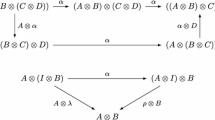Abstract
We describe the class (semigroup) of quantum channels mapping states with finite entropy into states with finite entropy. We show, in particular, that this class is naturally decomposed into three convex subclasses, two of them are closed under concatenations and tensor products. We obtain asymptotically tight universal continuity bounds for the output entropy of two types of quantum channels: channels with finite output entropy and energy-constrained channels preserving finiteness of the entropy.
Similar content being viewed by others
Notes
It is easy to see that \(S\) is the homogeneous extension of the ‘‘classical’’ Shannon entropy defined on the set of probability distributions to the positive cone of \(\ell_{1}\).
The support \(\textrm{supp}\rho\) of a positive trace class operator \(\rho\) is the closed subspace spanned by the eigenvectors of \(\rho\) corresponding to its positive eigenvalues.
In terms of the sequence \(\{E_{k}\}\) of eigenvalues of \(H_{A}\) condition (9) means that \(\lim_{k\rightarrow\infty}E_{k}/\ln k=+\infty\), while (10) is valid if \(\liminf_{k\rightarrow\infty}E_{k}/\ln^{q}k>0\) for some \(q>2\) [7, Section 2.2].
Theorem 3 in [14] shows that \(F_{H_{A}}(E)=O(\ln E)\) as \(E\rightarrow+\infty\) provided that condition (15) holds.
Pure states are rank-one projectors—extreme points of the convex set \(\mathfrak{S}(\mathcal{H}_{A})\).
in the sense described at the begin of this subsection.
It is shown in [15] that \(\sigma\textrm{-}\textrm{co}f\neq\overline{\textrm{co}}f\) for a particular lower semicontinuous concave nonnegative unitarily invariant function \(f\) on \(\mathfrak{S}(\mathcal{H})\), so the above conjecture can not be proved by using only general entropy-type properties of the function \(H_{\Phi}\).
In general, the discrete convex roof construction applied to an entropy type function (in the role of \(H\)) may give a function which is not equal to zero at countably non-decomposable separable states [15, Remark 6].
By Proposition 1 in Section 2.2 this holds, in particular, if \(\hat{F}_{H_{A}}=\hat{F}^{*}_{H_{A}}\).
A continuity bound \(\sup_{x,y\in S_{a}}|f(x)-f(y)|\leq B_{a}(x,y)\) depending on a parameter \(a\) is called asymptotically tight for large \(a\) if \(\limsup_{a\rightarrow+\infty}\sup_{x,y\in S_{a}}\frac{|f(x)-f(y)|}{B_{a}(x,y)}=1\).
REFERENCES
A. S. Holevo, Quantum Systems, Channels, Information. A Mathematical Introduction (De Gruyter, Berlin, 2012)
M. M. Wilde Quantum Information Theory (Cambridge Univ. Press, Cambridge, 2013).
M. E. Shirokov, ‘‘The continuity of the output entropy of positive maps,’’ Sb. Math. 202, 1537–1564 (2011).
A. S. Holevo and M. E. Shirokov, ‘‘Mutual and coherent information for infinite-dimensional quantum channels,’’ Problems Inform. Transmis. 46, 201–218 (2010).
M. E. Shirokov, ‘‘On characterization of positive maps preserving continuity of the von Neumann entropy,’’ Russ. Math. Surv. 71, 965–966 (2016).
A. S. Holevo, ‘‘Classical capacities of quantum channels with constrained inputs,’’ Prob. Theory Appl. 48, 359–374 (2003).
M. E. Shirokov, ‘‘Advanced Alicki–Fannes–Winter method for energy-constrained quantum systems and its use,’’ Quantum Inf. Process. 19 (164) (2020). https://doi.org/10.1007/s11128-020-2581-2
M. A. Nielsen and I. L. Chuang, Quantum Computation and Quantum Information (Cambridge Univ. Press, Cambridge, 2000).
G. Lindblad, ‘‘Expectation and entropy inequalities for finite quantum systems,’’ Commun. Math. Phys. 39, 111–119 (1974).
A. Wehrl, ‘‘General properties of entropy,’’ Rev. Mod. Phys. 50, 221–250 (1978).
M. Fannes, ‘‘A continuity property of the entropy density for spin lattice systems,’’ Commun. Math. Phys. 31, 291–294 (1973).
K. M. R. Audenaert, ‘‘A sharp continuity estimate for the von Neumann entropy,’’ J. Math. Phys. A: Math. Theor. 40, 8127–8136 (2007).
A. Winter, ‘‘Tight uniform continuity bounds for quantum entropies: Conditional entropy, relative entropy distance and energy constraints,’’ Commun. Math. Phys. 347, 291–313 (2016).
S. Becker and N. Datta, ‘‘Convergence rates for quantum evolution and entropic continuity bounds in infinite dimensions,’’ Commun. Math. Phys. 374, 823–871 (2020).
M. E. Shirokov, ‘‘On properties of the space of quantum states and their application to construction of entanglement monotones,’’ Izv. Math. 74, 849–882 (2010).
J. Eisert, ‘‘Entanglement in quantum information theory,’’ arXiv: quant-ph/0610253.
R. Horodecki, P. Horodecki, M. Horodecki, and K. Horodecki, ‘‘Quantum entanglement,’’ Rev. Mod. Phys. 81, 865–942 (2009).
J. Eisert, Ch. Simon, and M. B. Plenio, ‘‘On the quantification of entanglement in infinite-dimensional quantum systems,’’ J. Phys. A 35, 3911–3923 (2002).
M. B. Plenio and S. Virmani, ‘‘An introduction to entanglement measures,’’ Quantum Inf. Comput. 7, 1–51 (2007).
G. Vidal, ‘‘Entanglement monotones,’’ J. Mod. Opt. 47, 355–376 (2000).
C. H. Bennett, D. P. DiVincenzo, J. A. Smolin, and W. K. Wootters, ‘‘Mixed state entanglement and quantum error correction,’’ Phys. Rev. A 54, 3824–3851 (1996).
M. E. Shirokov, ‘‘Measures of correlations in infinite-dimensional quantum systems,’’ Sb. Math. 207, 724–768 (2016).
A. S. Holevo, ‘‘Additivity conjecture and covariant channels,’’ Int. J. Quant. 3, 41–48 (2005).
G. G. Amosov, ‘‘On Weyl channels being covariant with respect to the maximum commutative group of unitaries,’’ J. Math. Phys. 48, 012104 (2007).
ACKNOWLEDGMENTS
The authors are grateful to A.S. Holevo and to the participants of his seminar ‘‘Quantum probability, statistic, information’’ (the Steklov Mathematical Institute) for useful discussion.
Author information
Authors and Affiliations
Corresponding authors
Additional information
(Submitted by A. S. Holevo)
Rights and permissions
About this article
Cite this article
Shirokov, M.E., Bulinski, A.V. On Quantum Channels and Operations Preserving Finiteness of the von Neumann Entropy. Lobachevskii J Math 41, 2383–2396 (2020). https://doi.org/10.1134/S1995080220120392
Received:
Revised:
Accepted:
Published:
Issue Date:
DOI: https://doi.org/10.1134/S1995080220120392



